|
|
 |
Canadian Historic Sites: Occasional Papers in Archaeology and History No. 13
All that Glitters: A Memorial to Ottawa's Capitol Theatre and its Predecessors
by Hilary Russell
In the Beginning
To understand the Capitol and theatres like it, the movie palace
phenomenon must first be examined in its historical perspective. The
evolution of the movie house is a romantic story in the great American
"rags to riches" tradition. Until 1902 there was no such thing as a
movie theatre in a permanent location, though motion pictures as a
commercial medium were then eight years old. During these years they
were generally exhibited in penny arcades and fairground tents, and also
were crowded into vaudeville theatre programmes. After 1902 they found
exclusive and more or less permanent homes in small, stuffy converted
stores with rudimentary furnishings, characterized by many as "firetraps
and pestholes [which up set] the social balance and public
morals."1 A little over a decade after the appearance of the
primitive store theatre, movies had become the feature attraction in
colossal, sumptuous edifices too splendid to be called theatres.
Motion pictures were initially displayed in a viewing apparatus about
the size of a filing cabinet. This device, often credited to Thomas A.
Edison and called a "Kinetoscope," was essentially a coin-operated
peepbox in which one viewer could watch for a minute or less through a
slightly magnifying lens an illuminated cylinder of about 50 feet of
celluloid film revolving on spools. These machines were first
commercially exhibited in North America on 14 April 1894 at 1155
Broadway, New York, by Andrew and George C. Holland of Ottawa. Soon
afterward, Kinetoscopes appeared in "Edison parlours" (small stores
which also offered Edison phonographs), in curio shops and as fairground
novelties (Figs. 1-3).2

1 The forerunner of the movie house, a Kinetoscope parlour, around
1897-98, 946 Market Street, San Francisco.
(National Film Board:
photo credited to Peter Bacigalupi.)
|
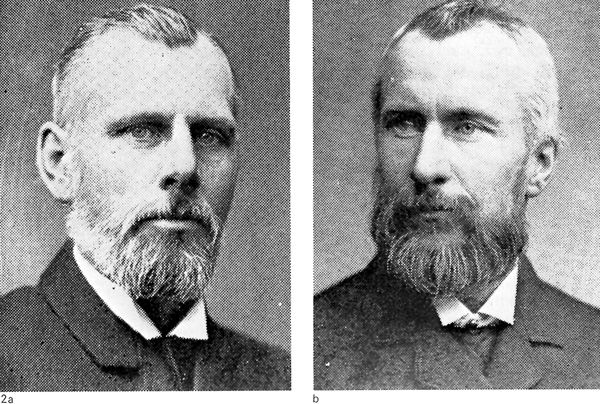
2 The first public exhibitors of Edison's Kinetoscope, Ottawa's Holland
Brothers, Andrew M. (left) and George.
(Canadian Film Institute.)
|
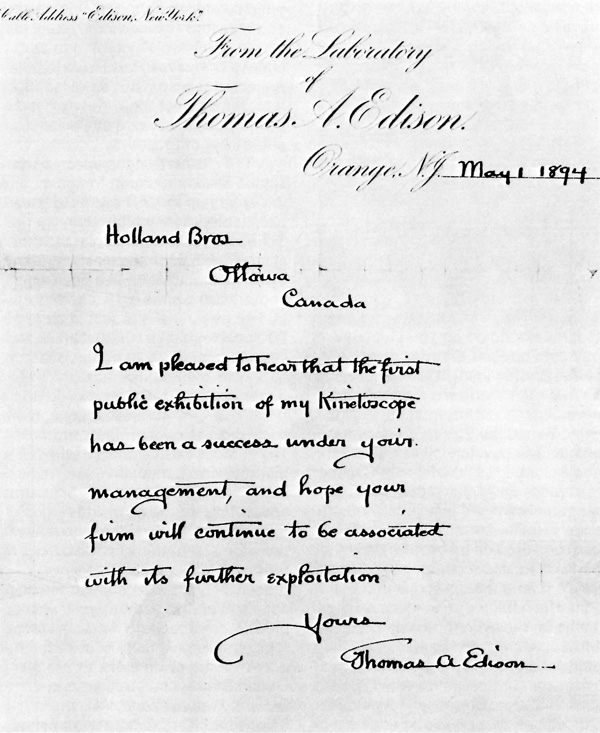
3 Edison's letter to the Holland Brothers acknowledging their pioneering
achievement. The exhibition referred to took piece in New York City on
14 April 1894.
(Public Archives of Canada.)
|
On 23 April 1896 motion pictures were screened to a paying audience
in a vaudeville theatre, Koster and Bial's Music Hall, Herald Square,
New York. "Thomas Edison's Latest Marvel, The Vitascope" shared the
billing with six vaudeville acts (Fig. 4). The Vitascope was a screen
projector developed by Thomas Armat, though acquired and sponsored by
Edison, and was based on the principles of the Kinetoscope. Motion
pictures became "life sized," and were revealed to the Koster and Bial
audience on a "gold framed screen," but the Vitascope movies, though of
increased footage, remained very similar in content to those seen
through a Kinetoscope peephole.3

4 Koster and Bial's programme, April 1899. As in Kinetoscope days,
little bits of scenery or action are featured.
(Ben Hall Collection,
Theatre Historical Society.)
|
After their commercial screen debut, motion pictures continued to be
shown in vaudeville theatres as one of many attractions on the bill.
Little expenditure was required to introduce moving pictures to a
vaudeville programme.
A simple screen was erected, often of plain muslin on a wooden or
iron frame, and an area sealed off for projection equipment. When the
stage was in use...the screen was lifted into the fly tower or carefully
rolled and stored at the back behind the flats.4
Motion pictures were associated with vaudeville for about 30 years in
the United States and Canada. Initially, the novelty of seeing
life-sized moving pictures was popular with vaudeville patrons. But
early moving pictures were short (100 to 1,000 feet in length), often
flickering and hard on the eyes (mostly because of imperfect
projection), and usually were devoid of narrative interest. Such
subjects as a moving train, sea waves, or various vaudeville acts were
filmed. By the turn of the century, moving pictures had lost their
novelty value, and were offered in vaudeville houses merely as "chasers"
to indicate that a new show was approaching and the house should be
cleared.5
By about 1914, with the introduction of feature-length movies, the
star system and a permanent industry in Hollywood, motion pictures had
come a long way from being a poor relation as a commercial medium and
had eclipsed their former master, vaudeville, in content, scope and
commercial appeal. Throughout the 1920s theatres continued to be built
with stage facilities as vaudeville was still popular, though seldom the
feature attraction, and theatres with a straight vaudeville policy had
become virtually a thing of the past. Furthermore, stage performances
tended to endow a theatre that showed movies with a certain
respectability.6 The humble and even disreputable beginnings
of motion picture exhibition had not been forgotten.
Between 1896 and 1902, besides being shown in vaudeville theatres,
moving pictures were exhibited by travelling showmen (mostly in the
summer in Canada) in community halls, empty stores rented for a week or
two, on vacant lots covered with tarpaulin, and at amusement parks,
circuses and fairs.
Although in accounts of Canadian film history, Toronto, Ottawa and
Montreal vie for the distinction of being the first Canadian city in
which travelling showmen projected moving pictures. Ottawa may have the
edge in the contest.7 John C. Green, a magician by trade,
early and frequently insisted in Moving Picture World and in the
Canadian Moving Picture Digest that his exhibition on 15 June
1896 in West End Park, Ottawa, was the earliest in Canada. His date
appears to be five weeks too early; contemporary newspaper accounts
indicate that an exhibition of the Edison Vitascope at an open-air
pavilion in West End Park and described as "the first...in Canada" took
place on 21 July 1896.8 This description is entirely
plausible, as Ottawa's Holland brothers, who had introduced the
Kinetoscope in the United States, had also secured "the sole right for
exhibiting the Vitascope in Canada." The Hollands had made arrangements
for the exhibition with O'Hearn and Soper's Electric Railway Company,
and this company had engaged a magician (whose name was variously
spelled Belzac, Belsac, and Belsaz in Ottawa newspapers) as an added
attraction. (Green no doubt was "Belzac," and used a more exotic name
than his own.) In his reminiscences, he recalled that he had contributed
a 30-minute magic show and had described four Edison 50-foot films which
were strung together in a belt and repeated as long as the projector was
in operation. According to an Ottawa Daily Free Press reporter,
the projected scenes included "a laughable representation of the widow's
kiss," a whirlpool, the waves at Coney Island and a view of Broadway.
The closest thing to specially designed accommodation for the movies
in Canada up to 1902 seems to have been a black tent which John A.
Schuberg (alias Johnny Nash), a travelling showman in the western
provinces, averred that he had devised about 1900. Schuberg's tent
measured 20 feet by 60 feet and seated about 200 people. It was made of
black canvas with an inner tent of black canton flannel to keep out the
sunlight when it was windy. The "sidewall" could be raised every 20
minutes at the end of each show to cool off the patrons. The exterior
was decorated with a marquee-like banner on poles, together with fairly
lurid paintings or posters advertising the movie inside (Fig.
5).9 Schuberg conceded, "I may not have been the first to
think up the black tent, but I had not heard of any
others."10 Such modesty was uncharacteristic of early
exhibitors. It was appropriate in Schuberg's case. as black tops had
become fairly popular by that date with travelling exhibitors in the
United States. In a 1916 article in Moving Picture World, William
H. Swanson related that he had opened "the very first black top tent
that was ever put up" in Booneville, Indiana, in July, 1897. His tent
was of dyed black canvas and was lined with black cotton cloth. His
exhibition was interrupted when a rain storm washed all the dye out of
the canvas, but a tent-maker subsequently produced for him a permanently
black tent. Swanson later contrived a red canvas tent lined with black
cloth with "properly protected ventilators in the 'top'" — he had
noticed that a great number of his black-top patrons were regularly
overcome by the summer afternoon heat. If it is true, Swanson's account
of the entertainments offered in his "Red Dome" perhaps vaguely
foreshadowed later movie palace extravaganzas.
The exhibition...consisted of 2,000 feet of motion pictures, the
singing of the "Holy City" by an illustrated song singer, poses
plastique, fire and serpentine dancing staged with proper electrical
effects, electric glass water fountains on each side of the stage, a
spray of water from the proscenium arch on which stereopticon slides
were projected, silk rags with electric fans underneath and gelatine red
effects thrown on them while they were blown in the air from the stage
floor.11
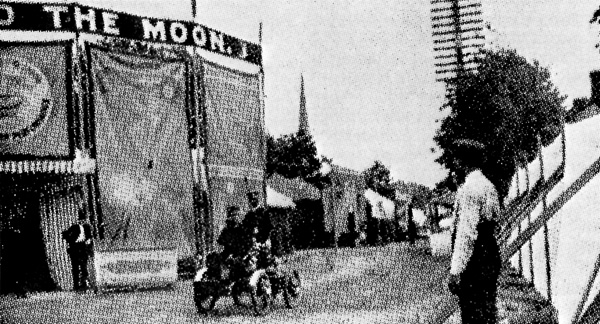
5 John A. Schuberg's tent theatre at a 1900 street fair. This was the
earliest type of structure especially designed for moving picture
exhibition.
(Canadian Film Digest; photo courtesy of National Film
Board.)
|
Between 1903 and 1905 another type of structure emerged which was
specifically adapted to motion pictures. George C. Hale of Kansas City
built for the St. Louis Exposition an imitation Pullman car in which
moving pictures taken from moving trains were projected. The attraction
was billed as "Hale's Tours and Scenes of the World." The entrance to
the "theatre" was fashioned to resemble the observation platform of a
caboose, and the ticket collector was sometimes dressed as a train
conductor. About 70 patrons, ensconced in regulation coach seats, could
watch life-sized tracks seemingly disappearing under the coach and
spectacular scenery flashing by on a screen or sheet at the "forward
end." Special effects heightened the illusion; these were provided by
"an elaborate equipment of levers, pulleys, wheels, and sound-making
devices."12 In addition, the structure was frequently joggled
either mechanically or by an attendant outside. Thus, the patron not
only heard the locomotive whistle, the wind rushing by and the brakes
being applied, but he was jolted and tipped from side to side as the
"train" rounded a curve or gathered speed. Motion pictures had yet to
find a home in a solid, permanent structure. Many exhibitors adopted
Hale's device; imitation trains proliferated as an amusement park
attraction. As well, they appeared in Vancouver, Winnipeg and Toronto by
about 1905;13 but the novelty of the exhibition soon wore
off, a contributing factor being that exhibitors were hard-pressed to
change their programmes often enough to attract new patronage, in spite
of the fact that films were being produced expressly for Hale's
Tours.
Until about 1905-06 such shortages of films generally obliged
exhibitors to keep moving. They usually bought a limited quantity of
films from producing companies and exhibited in as many locations as it
took for their prints to wear out. Permanent movie theatres were not
established in quantity until there was sufficient film available for
rent to exhibitors from film exchanges to allow for regular changes of
programme on one site, and until the advent of the story picture. When
these conditions were met, the general standard of motion picture
exhibition took no great leaps forward. Between about 1905 and 1907,
more or less permanent cinemas were established in small converted
stores, dance halls and converted penny arcades. Though these were their
habitual locations, they could also be found in skating rinks,
deconsecrated churches, or in virtually any building (preferably on a
main street) that was available at a reasonable rental (Figs. 6, 7).
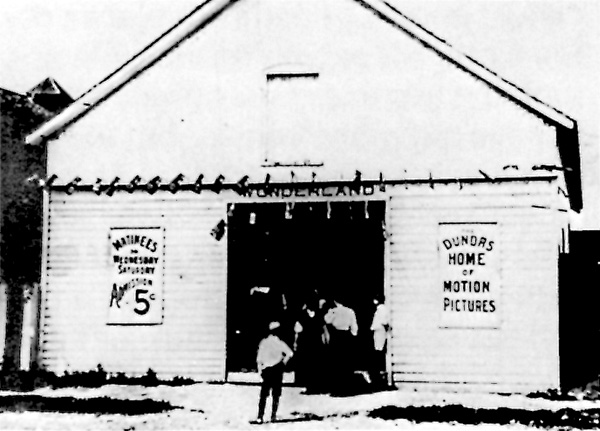

6, 7 Two Canadian "converts." 6, A converted barn in Dundas,
Ontario, ca. 1909. (Archives of Ontario.) 7, The Dreamland in
Edmonton about 1910.
(B. Brown Collection, Archives of Alberta.)
|
To convert a small commercial establishment into a movie theatre,
enterprising exhibitors replaced the store fronts with a set of doors
and a small wooden box office set back from the sidewalk, thus creating
a tiny, wind swept "lobby" which was decorated with florid movie
lithographs. The strident music and announcements of a phonograph and a
barker in this area were additional enticements. Usually, the theatre's
name was inscribed on either a large canvas, wooden or electric sign
over the entrance doors.14 Some of these premises were
perhaps 25 feet wide and 100 feet long and, as auditoriums were narrow,
dark, and ill-ventilated. They seated as many as the room would hold,
either on unfastened "kitchen" chairs, wooden benches nailed together in
rows, or on folding chairs rented by the day from undertaking or
catering establishments. (In the latter case, patrons were forced to
stand when the owners reclaimed their chairs.)15
When there was a full house, the auditorium was oppressively hot; a
1907 store show exhibitor recalled that "there was an average of two
women fainting every Saturday night, and they were wedged in so tight
they couldn't fall."16 On such nights, the air in the
auditorium quickly became stale and sour. Some measure of relief was
afforded by thoughtful exhibitors who installed small wall fans (which
mostly churned up stale air) or who occasionally left a door open. From
time to time, vain attempts were made to deodorize the auditorium by
aiming a garden sprayer filled with cheap scent over the heads of the
assembly.17
It was widely assumed that the best picture was projected in the
darkest auditorium, thus any windows were covered with black cloth (or
even paper), and interior decorations were, in most cases. non-existent
or minimal.18 Often the projector was merely roped off in the
middle or at the back of the room. If a cloth-covered projection booth
was provided, it was usually barely large enough for one projector and
the operator, and he could not move about without agitating the "walls"
of the booth. Like many of his colleagues, the operator in the tin-lined
booth at the Vitascope on Mount Royal East in Montreal could not stand
upright.19 The projectors were hand-cranked, and were
equipped with a stereopticon attachment, frequently used to project a
slide asking for "One Moment Please."20 The film fed through
the projector accumulated in a heap either in a galvanized iron tank or,
in the "cheaper" houses, in a barrel, cloth bag, or a basket on the
floor. When the film broke, the operator was obliged to paw around in
the tangle of film to find the right end. He was not always successful,
an early exhibitor remembered, and "when the reel was run off the next
time, the last part would come first, then the next part would probably
be upside-down, and the end came in the middle of the
picture."21
A painted or plastered wall, a bed sheet or a large canvas served as
the screen. In front of it, a "classy" store theatre had a small stage
or platform used by the lecturer who interpreted the movies and by
singers of "illustrated songs." Illustrated songs were a variety show
invention, but they usefully filled the interval between reels in a
movie house. The ballad singer (or singers) was accompanied by a pianist
(installed on or near the "stage") and by a series of stereoptcon slides
appropriate to the mood and story of the song.22 (The editor
of Moving Picture World once unkindly suggested that the singers
worked with slides so that the darkness would spoil the aims of
projectile throwers in the audience.)
The pianist (who was sometimes also the ballad singer) played an
accompaniment for the movie. but in many cases this was simply whatever
he felt like playing or knew by heart. A few houses in 1908 had a
three-piece orchestra consisting of a pianist, a violinist and a
drummer. If the members were in a playful mood, they might race each
other, and "the heroine could die to the tune of 'Turkey in the Straw'
played four times the usual speed for all the orchestra
cared."23
The programme was changed every 15 to 30 minutes, and the patron was
charged five cents though theatres with elaborate illustrated song
presentations often levied a dime (Fig. 8). These five-cent theatres,
considered the province of the poor and uneducated, swarmed across the
continent after 1905 and were largely concentrated in poorer shopping
districts and slum areas. They were disdained, apparently, as dens of
vice by large sections of the population.24 According to
Adolph Zukor, his first theatre, "The Comedy," was "not an exclusive
theatre. In fact, the ushers carried blackjacks."25

8 Nickelodeon Recollections, published in Moving Picture World,
vol. 37 (10 August 1918), p. 83.
|
Store theatres, or, as they came to be called, nickelodeons, are
usually discussed in secondary works on the film industry as forerunners
of the movie palace. They have received this attention partly because
the phenomenon was fairly short-lived and widespread, and partly because
of their jarring contrast to the movie palaces built only ten years
later.26 Yet there appears to be comparatively little
published research on the genesis and evolution of the vaudeville house,
which movie palaces more closely resembled.27 Like the
palaces, vaudeville houses followed the basic design of the legitimate
theatre with balconies, orchestra, boxes and stage. Though they paled
beside the opulence of the great movie palaces, many vaudeville houses
were pretentiously appointed.
The Keith-Albee circuit is reported to have built... the finest
theatres in the world for vaudeville. Beautiful lobbies with oil
paintings that cost thousands of dollars, rugs that cost more thousands,
dressing rooms that compared to the finest hotel suites.... They were
cathedrals.28
But even the earliest movie theatres aspired to middle-class
acceptance and money. One of the earliest, if not (as is often claimed)
the first regular commercial cinema, opened at 262 South Main Street in
Los Angeles in April 1902, was advertised by its owner, Thomas L. Tally,
as "The Electric Theatre. For Up-to-date High Class Entertainment.
Especially for Ladies and Children" (Fig. 9).
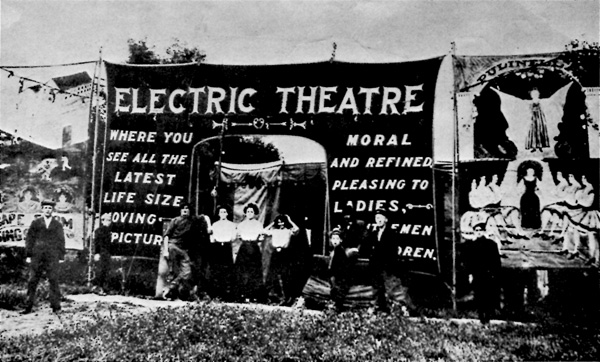
9 This photograph is often identified as Thomas Tally's 1902 Electric
Theatre in Los Angeles. It appears to be a canvas-fronted fairground
show.
(Canadian Film Institute.)
|
In October of the same year Canada's first lasting movie house, the
"Edison Electric Theatre," was opened by John A. Schuberg at 38 Cordova
Street, Vancouver. One of its printed programmes for February 1903
announced that an usher was in attendance to see that the ladies
obtained desirable seats.29
As a travelling showman, Schuberg had exhibited movies for two weeks
in 1898 on Cordova Street. He recounted that he had "rented a fairly
large, empty warehouse..., set up the equipment near the front and hung
the screen at the back. As the show could only run about 30 minutes,
seats were not necessary." But Schuberg provided no comparable
description of his 1902 Edison Electric beyond the biographical comment
that he opened "a similar house" in 1903 in Winnipeg in a high-ceilinged
storeroom.30
Tally's Electric Theatre offered movies as the exclusive
entertainment, while Schuberg's Edison Electric supplemented the
programme with vaudeville acts. Though the absence of film exchanges and
the scarcity of films must have precluded frequent and regular changes
of programme, both enterprises were quite successful and their owners
opened other theatres.31
The astonishing commercial success of John Harris and Harry Davis'
"Nickelodeon" opened in Pittsburgh in June 1905 was the real impetus
behind a flood of store-theatre openings. This theatre does not seem to
have initiated an exclusive motion picture programme on a permanent
basis as it is sometimes maintained. Probably, it became the most famous
of the early movie theatres because it made a great deal more money than
its predecessors.32 The owners were among the first to infuse
the showmanship into their store theatre enterprise which was eventually
to lead the industry to construct movie palaces. They adopted the name
"Nickelodeon" for their establishment, a combination of its admission
price and the Greek word for theatre. A projector, a phonograph and a
white sheet were installed in an empty store, and the auditorium was
dressed up with theatre chairs from the local Grand Opera House. Harris
and Davis also introduced alot of stucco, burlap, paint and incandescent
lights as well as piano accompaniment to the silent
drama.33
The success of this theatre coincided with the establishment of film
exchanges, and in 1906 so many store theatres opened that in October of
that year The Billboard of New York reported,
"No one is in a position to estimate the number of these exhibits
which are now in operation, for an estimate today would be worthless
tomorrow. In all big cities they seem to be on every business
block."34
This was also a significant year for Canadian exhibition. The first
lasting exclusive moving picture theatre in Toronto, "The Theatorium,"
was opened by John Griffin in March, 1906 on Yonge Street near Queen,
near the site of the present Yonge Theatre (Fig. 10). Griffin described
the Theatorium as
"not much more than a hole in the wall, for it was only seventeen
feet wide and a hundred feet deep. But it was a first-class site. That's
where people were passing up and down."35
Moving pictures and variety acts were offered for five cents. Griffin
noticed that his admission price seemed too low; many people were
ashamed to be seen going in. He raised the price to ten cents and so
prospered that, together with his son Peter he eventually operated the
Majestic, a legitimate theatre converted to vaudeville and movies, and
eight store theatres in Toronto as well as a number of combination
(vaudeville and movie) theatres and store shows in other Ontario centres
including Hamilton, St. Catharines, Sarnia, Chatham, Woodstock, Thorold,
Welland, Kingston, and Brockville.36
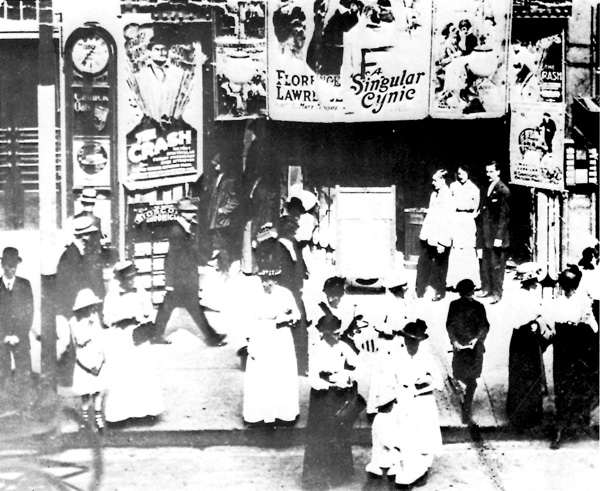
10 Toronto's first permanent movie house, John
Griffin's store theatre on Yonge Street. Originally called Theatorium,
its name was changed to The Red Mill by the time this photograph was
taken.
(Canadian Film Digest; photo courtesy of
Theatre Department, Metropolitan Toronto Central Library.)
|
The Theatorium was a marked contrast to Toronto's deluxe vaudeville
house, Shea's Yonge Street, built in 1899. According to a contemporary
newspaper account, Shea's lobby was beautiful, its walls tiled in white
with large oval mirrors in each panel, surrounded by wreaths in rose and
green tile. The reviewer was particularly impressed with the asbestos
drop curtain, "the Chief thing of beauty," on which was a painting, "The
Rising of the Mists," by Gustave Hahn.37
What was to become the first national Canadian circuit was begun in
the fall of 1906 by Bernard Allen and his sons Jay and Jule, American
emigrants from Bradford, Pennsylvania. They opened a store theatre (also
called the Theatorium) on Colborne Street in Brantford, Ontario, which
they equipped with 150 kitchen chairs and a bed sheet tacked on a rough
board frame for a screen. With its continuous show for five cents
admission, it was so profitable that the Allens could afford to spend
$2,000 equipping "The Wonderland," their second theatre in
Brantford.38 By 1909, the Allens had formed a film exchange
to serve their growing circuit. The chain soon spread to other western
Ontario centres, and eventually was expanded from Quebec to British
Columbia (Fig. 11).

11 A 1909 Allen Theatre in Berlin (Kitchener) Ontario. Handmade and
movie posters substitute for a marquee.
(Archives of Ontario.)
|
Another Canadian chain was started in 1906 by C. W. Bennett of
London, Ontario. Bennett Theatrical Enterprises were mostly concerned
with vaudeville theatres, though they operated several movie houses.
Bennett establishments could be found in London, Hamilton, Ottawa, St.
Thomas, Montreal, Quebec City, Saint John, Halifax and Sydney (Fig. 12).
The circuit foundered when it attempted to expand into South America. By
1909-10, its theatres had been sold, mostly to local businessmen.

12 Members of the Bennett vaudeville theatre
circuit. On the right, a closer look at Bennett's theatre, Ottawa (later
the Dominion).
(Public Archives of Canada.)
|
Bennett movie theatres were uniformly named "Unique," and seem to
have been little better than store shows, Bennett vaudeville theatres
were affiliated with the Keith circuit and were considerably grander.
"Bennett's," one of the circuits vaudeville theatres in Hamilton, was
a veritable jewel with decor of light green and red, with red
plush seats and red plush curtains in the boxes which were embellished
with cupids and floral designs and brass railings. The theatre even had
an isolated chamber for acts featuring trained
animals.39
It was designed by E. C. Horn of New York, and built in 120 days in
1907 (Fig. 13).

13 View of proscenium arch and stage area of the Savoy vaudeville
theatre in Hamilton, operated by the Bennett circuit between about 1907
and 1909.
(Famous Players Limited.)
|
Bennett's vaudeville theatre, which opened in December 1906,
introduced regular showings of moving pictures to Ottawa under the
patronage of the Governor General, Lady Laurier and the Mayor. Although
the movies were only a minor attraction on the bill, the Journal
reviewer enthused that they were "the best ever shown in
Ottawa."40 He was also fulsome in his description of the new
theatre's interior, which he judged as
handsome — decorated with many beautiful paintings and scenic
effects. Decorative effects in entrance are of Pompeian style with
Bacchante figures worked out to advantage. In the dome of the main part
of the ceiling, the paintings are magnificent, being worked out in old
Italian style. The centre figure represents music, with a fairy dancer
on one side and on the other figures representing music.
The paintings were the work of Frank Righetti of New York, and the
theatre's architect was E. C. Horn. In addition, the theatre provided 18
exits, a ladies' parlour with a "courteous maid," writing material and
recent magazines for waiting patrons, and a telephone messenger
service.41 For the next 14 years this theatre, renamed the
Dominion when the Bennett circuit expired, was Ottawa's "number one"
vaudeville house.
Within about a year of this theatre's successful presentation of
motion pictures in a permanent location, at least three store theatres
opened in Ottawa; the Unique (a combined penny arcade and auditorium)
and People's on Rideau Street, and the Nickel at 140 Albert.
The year 1906 was also a key year for moving picture exhibition in
Montreal. In January L. Ernest Ouimet opened what was to become one of
Montreal's first successful enduring movie houses in Poire Hall, a
rented dance-hall and former vaudeville theatre on the corner of Ste.
Catherine and Montcalm streets. It attracted so many patrons that in the
spring it was closed for alterations. Its kitchen chairs were exchanged
for theatre seats, its capacity enlarged from 450 to 600, and another
entrance was provided on Ste. Catherine Street. Ouimet began imitating
legitimate theatre operations, offering two shows a day and "illustrated
songs," and reserved seats for 25 cents (Fig. 14). In April Ouimet
opened a similar house in Karn Hall, another rented dance-hall, between
Peel and Metcalfe on Ste. Catherine. He planned to shift the programme
from the first to the second "Ouimetoscope" after a week's run. The
second theatre (which was a second-storey establishment) closed about a
month later42 (Fig. 15). Nevertheless, the success of the
first Ouimetoscope seems to have generated such nickel theatres as the
Cinematograph Canada on St. James, the Starland and the Crystal Palace
on St. Lawrence, the National Biograph on Notre Dame Street West, and
the Nickel on Ste. Catherine Street West.

14 Exterior of Ernest L. Ouimet's "Ouimetoscope" one of Montreal's first
enduring movie houses.
(Canadian Film Digest.)
|
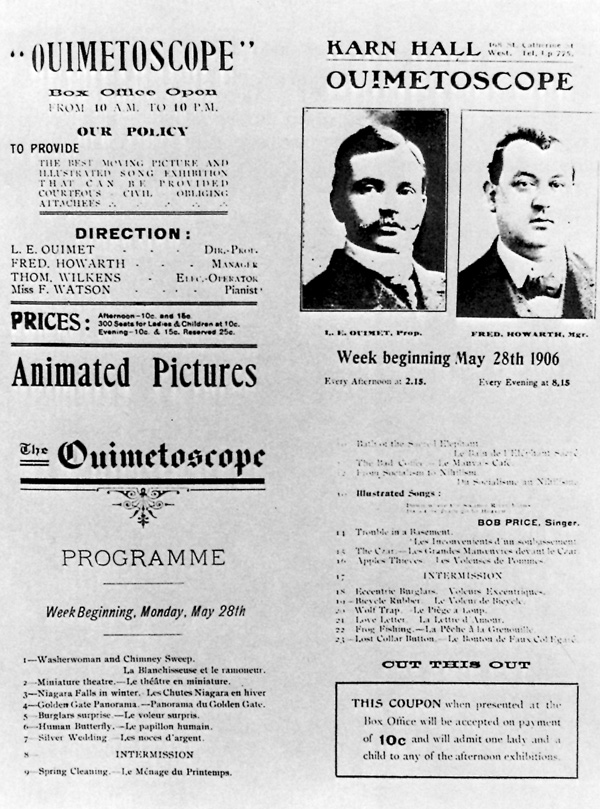
15 Programme of the second Ouimetoscope, with a photograph of its young
owner.
(Canadian Film Digest.)
|
In May of 1907, Ouimet demolished his first theatre on Ste. Catherine
and Montcalm. A building even more significant was to take its place. He
opened on the site in August 1907 the first deluxe movie theatre on the
North American continent. This Ouimetoscope reportedly cost about
$50,000 and was one of the first movie houses constructed as such from
the ground up. With dimensions of 42 feet by 150 feet, it seated 1,000
in plush surroundings and offered such amenities as a tiled lobby,
reserved seats for 35 cents, a balcony, checkroom facilities and a house
magazine. It operated on a theatrical basis, with two shows a day and a
10-minute entr' acte. A seven-piece orchestra and illustrated
songs supplemented six reels of moving pictures (Figs.
16-18).43
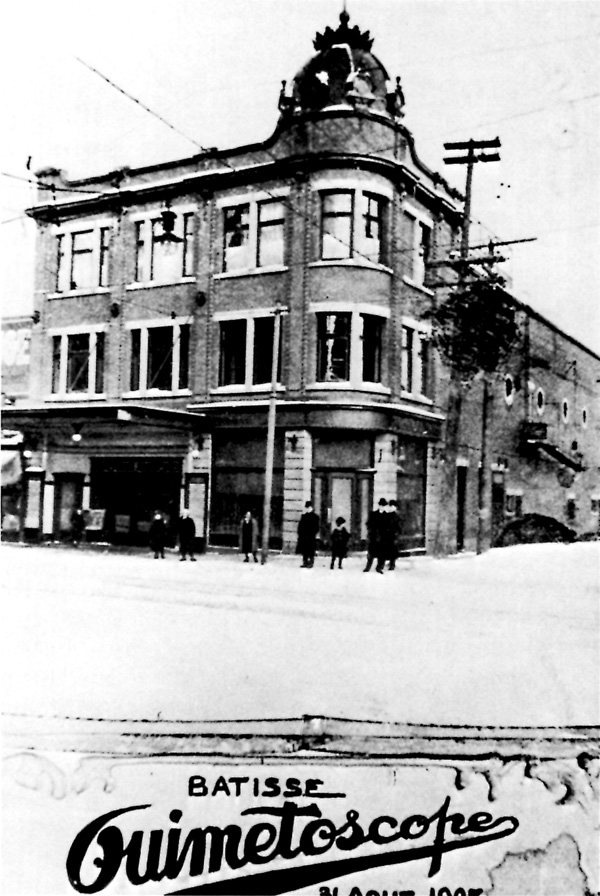
16 Exterior of the 1907 Ouimetoscope, the first deluxe movie house in
North America.
(Canadian Film Digest; photo courtesy of National Film
Board.)
|
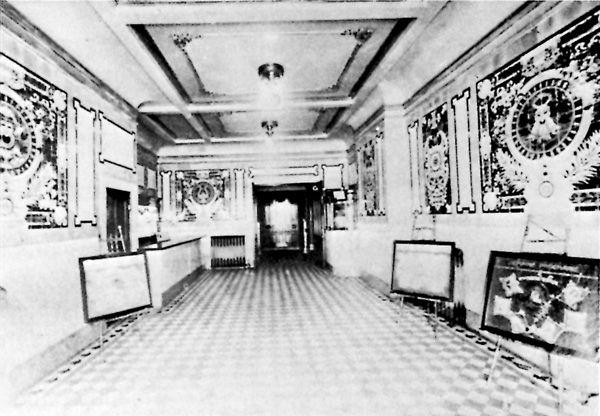

17, 18 Lobby and auditorium of the 1907 Ouimetoscope in January 1908.
The motifs on the tiled lobby walls depict theatrical muses. In the
auditorium, notice she orchestra pit, comfortable theatre seats, and the
decorated balcony and box fronts. Evidence of the check room can be seen
in the coatless audience.
(Canadian Film Digest; photos courtesy of
National Film Board.)
|
According to Ouimet, the only other building at all comparable to the
Ouimetoscope was a 1,000-seat movie theatre in Pittsburgh, apparently
built for the purpose in 1906 or 1907 by Sigmund Lubin. His theatre had
"an elaborate nickelodeon front," but unlike the Ouimetoscope operated
as a "grind" house with five- and ten-cent admissions; its entertainment
was two reels of moving pictures, one illustrated song and a piano
player.44
In general, between 1907 and 1910, moving pictures were neither
sophisticated nor long enough to warrant such exclusive surroundings,
and the Ouimetoscope did not long maintain its splendid programme, and
by 1910 had deteriorated to a "grind" house. Nevertheless, between about
1907 and 1912 many exhibitors relentlessly pursued respectability and
the "family trade" by dressing up their makeshift or newly built
theatres and by paying some attention to the comfort and safety of the
audience.
At first, most attention was concentrated on the building fašade.
Arched fronts (over the lobby and entrance doors) appeared at least as
early as 1905, and by 1909 they apparently graced the majority of
five-cent theatres. If they were symmetrical and proportional they
created a pleasing effect, but many were not and the feature came to be
known as a "Coney Island front"45 (Fig. 19).
The fairground or midway past of moving pictures could be recalled in
other exterior treatments which nearly put a circus wagon in the
shade.46 Lobbies and fronts were crowded with a profusion of
cheap plaster decorations (always called "gingerbread decorations" by
purveyors of good taste writing in Moving Picture World) which
were painted colours that "shout[ed] louder than the most leather-lunged
barker."47 A quantity of electric lights supplemented these
decorations, and were intended as enticements to passers-by, on whom
exhibitors largely relied (Figs. 20-22).
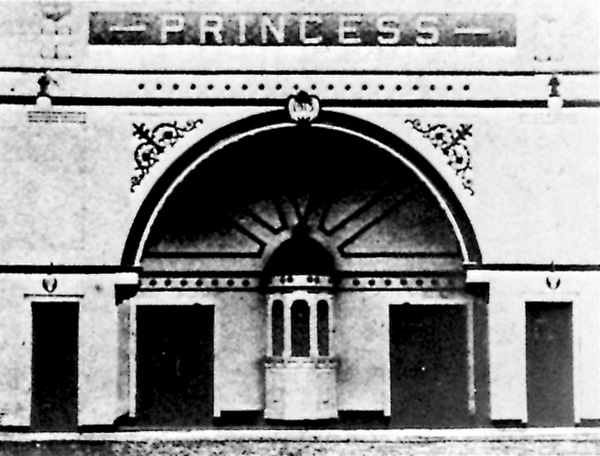

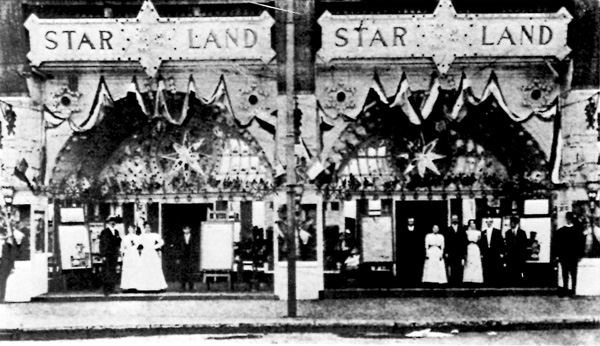

19, 20, 21, 22 Fašades of "new, improved" movie
houses. 19, A "Coney Island" front, Princess Theatre, Melville,
Saskatchewan. (Moving Picture
World.) 20, The Starland in
Calgary, ca. 1909, with very faint glimmerings of movie palace
glitter. (Glenbow-Alberta
Institute.) 21, The Starland in
Montreal dressed up for the coronation of George V, 1911. (Moving Picture World.) 22, A good example of gingerbread style —
the Majestic in Winnipeg in 1911.
(Moving Picture World.)
|
To this purpose, Sigmund Lubin had introduced in 1906 or 1907 pressed
metal fronts which were fitted over and camouflaged the old store fronts
and extended well above the first storey. These could be bought for
between $1,500 and $2,000 and, painted and strung out with electric
lights, were meant to suggest that a "real theatre" lay behind the
fašade. The 250-seat Starland, opened on St. Lawrence Boulevard in
Montreal in 1907, had a front of this type which, unfortunately, fell
victim to a fire not long after the opening.48
Other artifices to impress the middle class included "etched plate
glass mirrors," "tiled flooring," potted plants, and "artistically
framed" lithographs in the lobby area.49 The second storey
Red Mill in Hamilton in 1907 (and a number of other theatres which
possessed a flight of steps) dazzled patrons with "Rainbow Stairs."
These were made of glass, and covered running water illuminated by
varicoloured bulbs. The impression gained was that of walking up a
waterfall.50
Nevertheless, a nickelodeon patron was often ushered from a bright
and overdecorated front into a gloomy interior as, until indirect
lighting systems came into vogue in about 1910, interior decorations
could be considered virtually a waste of money. With the advent of aisle
lights and properly dimmed and shaded auditorium lighting, interior
decorations could be illuminated without interfering with the projection
of the picture.51 As well, patrons no longer had to grope and
stumble around in the darkness attempting to find empty seats.
By about 1908, folding chairs had given way to "cheap tip-up chairs
with veneer seats and backs." Unupholstered opera chairs also began to
appear in movie theatres. Exhibitors were counselled in 1909 that
"upholstered seats are not desirable...from any point of view," as
unupholstered seats were cooler in the summer and perfectly comfortable
for the comparatively short time patrons were seated. Nevertheless, in
about 1910 the spring seat with "pantasote" or fabric cover began to win
adherents.52
Other features common to legitimate and vaudeville theatres appeared
in some movie houses. These included sloped floors, balconies, waiting
rooms, toilet facilities for staff and patrons, and fire exits. The
phonograph and barker were replaced by a uniformed doorman and uniforms
were provided for the ushers. These advances, to some extent, kept pace
with the generally improved quality and entertainment value of moving
pictures, but as well, were often made in response to new governmental
regulations on safe moving picture exhibition.
Like Ernest Ouimet, other exhibitors whose makeshift theatres had
prospered began to build movie theatres from the ground up. However,
between 1907 and about 1911-12, this type of movie house was probably
the exception, and was by no means ipso facto de luxe. For
example, Vancouver's Maple Leaf theatre built in 1907 accommodated 500
kitchen chairs. Indeed, many flimsy structures were hastily put up, as
their proprietors did not expect them to last for more than one
season.53 Among the theatres of the new improved type that
were operating in Canada in 1911 were the new Starland in Montreal, the
Starland in Winnipeg, and the Princess in Vancouver. The Winnipeg
Starland seated about 750 and was served by a four-piece orchestra. Its
interior decorations were "in deep rose and bronze with many hanging
flower baskets."54 Shortly after its opening, a Moving
Picture World correspondent provided the following description of
the 450 seat Princess in Vancouver.
The front of the building follows in its general design the
Romanesque style of architecture. Inside, it is modern in every respect.
The auditorium is lighted by hundreds of softly colored incandescent
lights, so arranged that there is no glare, the light being thrown
against a mauve ceiling and reflected downward. The picture screen of
white satin is placed back of the proscenium arch. The arch is fringed
on the inner side by a beautiful decoration in art glass, through which
the lights shine softly....The slope of the floor is so arranged that
every person in the audience can see over a picture hat....On the right
side of the auditorium, at the side of the stage, is a comfortable
retiring room, with all modern accessories.55
It was the successful introduction of the multi-reeled or
feature-length film that demanded the most fundamental changes in
exhibition. High turnover, the basis of nickelodeon profit, was no
longer feasible.56 Furthermore, such feature-length moving
pictures as "Quo Vadis?" and "Judith of Bethulia" rivalled legitimate
productions in content, "class," and length, and needed more elevated
and formal screening surroundings than fusty nickelodeons. In New York
City, the producers of these features leased first-class Broadway
theatres and were confident enough to charge first-class Broadway
prices.57 The movies had achieved a measure of
respectability.
Henry L. Marvin decided to enter the exhibition field with the idea
conceived by Ouimet five years before: that motion pictures required a
special, "high class," expensive theatre. In February 1913 he opened the
Regent at ll6th Street and 7th Avenue, the first deluxe theatre built
expressly for showing movies in New York City (Fig. 23). From the Regent
it was a short step to the glorious excesses of the movie palace.
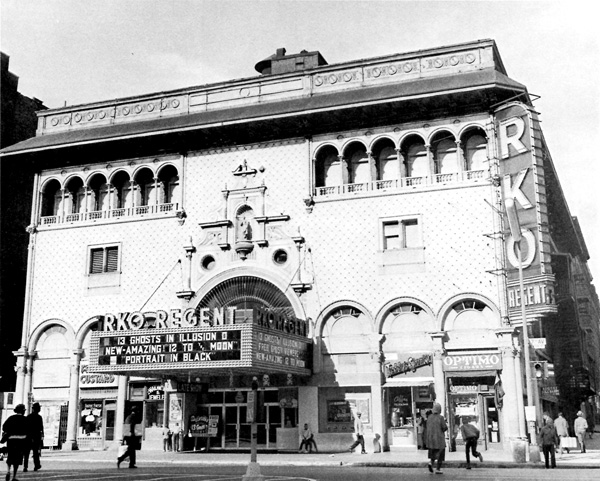
23 The Regent, opened in 1913, New York's first deluxe movie theatre,
designed by Thomas W. Lamb.
(Ben Hall Collection, Theatre Historical
Society.)
|
|

